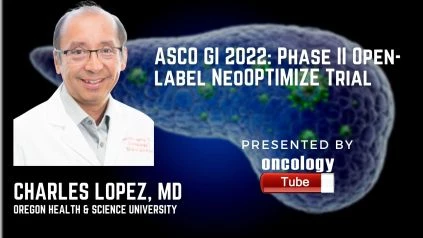Charles Lopez, MD, Ph.D., Associate Professor of Medicine, School of Medicine Cell and Developmental Biology Graduate Program, School of Medicine, Cancer Biology Graduate Program, School of Medicine Program in Molecular and Cellular Biosciences, School of Medicine at Oregon Health & Science University (OHSU). In this video, he speaks about the ASCU GI 2022 Abstract – NeoOPTIMIZE: An open-label, phase II trial and biomarker discovery platform to assess the efficacy of adaptive switching of modified FOLFIRINOX (mFFX) or gemcitabine/nab-paclitaxel (GA) as a neoadjuvant strategy for patients with resectable/borderline resectable and locally advanced unresectable pancreatic ductal adenocarcinoma (PDAC).
Â
Origins:
Â
Patients with localized PDAC may benefit from neoadjuvant chemotherapy (NAC) and/or chemo-radiation therapy (chemo-RT) because of improved tolerability, tumor downstaging, and greater R0 resections. The current NAC backbones are mFFX or GA; however, the lack of a solid predictive biomarker(s) makes it difficult to identify individuals who are most likely to benefit from mFFX or GA. Furthermore, NAC efficacy is hampered by desmoplastic stroma and poor vascularity, whereas losartan, an angiotensin II receptor inhibitor, may improve chemotherapeutic action by remodeling vascular perfusion. The NeoOPTIMIZE trial was created for patients with newly diagnosed localized PDAC to provide a flexible clinical platform to 1) assess the feasibility and efficacy of switching from mFFX to GA early, and 2) develop a robust biomarker/imaging discovery platform to optimize the NAC backbone.
Â
Methodologies:
Â
NeoOPTIMIZE is a non-randomized, open-label phase II trial that will evaluate the efficacy of an adaptive therapy method that allows for early switching of NAC in patients with localized PDAC. Sixty patients (40 resectable/BRCP; 20 uLAPC) will be enlisted to undergo two months of preoperative mFFX (oxaliplatin, 85 mg/m2; folinic acid, 400 mg/m2; irinotecan, 150 mg/m2; 5-FU, 2400 mg/m2), followed by restaging by a multidisciplinary tumor board (multiD-TB). Patients continue to get mFFX if there is no advancement (per panc protocol, CT and CA19-9 decline/increase 30% from baseline) (4 cycles). Patients are switched to GA (nab-paclitaxel, 125 mg/m2; gemcitabine, 1000 mg/m2) for 2 months if they advance (by panc protocol CT; CA19-9 rise > 30%). Another restaging multiD-TB will decide whether to proceed with: a) RT (if vascular involvement) then resection, b) resection or c) continuing chemo after 4 months of mFFX or mFFX/GA (if unresectable). Throughout the NAC and RT regimens, losartan (50 mg PO QD) is administered. The primary endpoint calculates the percentage of resectable/BRPC patients who have received R0 resection. If the proportion of R0 is 60%, a sample size of 32 will yield a 95 percent confidence interval of 0.41 – 076. A total of 40 patients will be enrolled in the primary endpoint to allow for a 20% dropout rate. Twenty uLAPC patients will be enrolled in a separate experimental cohort. DFS, PFS, OS, and AEs are examples of secondary endpoints. Correlating clinical outcomes data with changes in blood-based biomarkers (CA19-9, ctDNA, circulating tumor cells, etc.) and study DCE-MRI are among the exploratory objectives. We’re collecting tumors to use deep multi-omic analytics to correlate clinical data with deep multi-omic analytics. At the time of submission, there were six patients participating in the trial. NCT04539808 is the number for the clinical trial.

